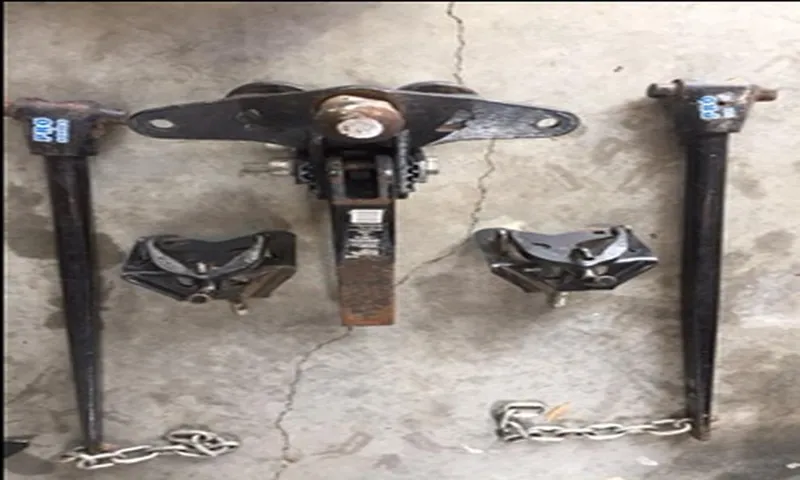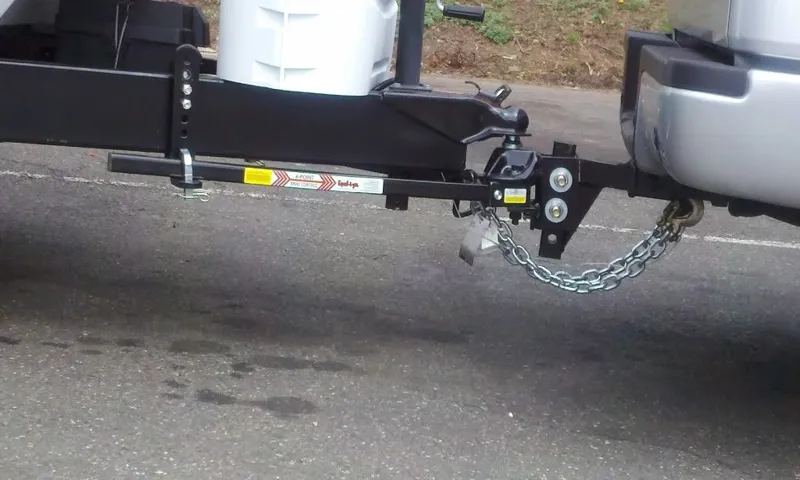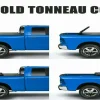Hey there! Have you ever wondered how people manage to haul heavy loads in their trailers without their vehicles sagging or swaying? Well, the secret lies in using an equalizer hitch. But what exactly is an equalizer hitch and how does it work? An equalizer hitch, also known as a weight distribution hitch, is a device designed to distribute the weight of the trailer evenly across the towing vehicle and trailer axles. It’s like a balancing act for your towing setup, ensuring that the weight is properly distributed and keeping your vehicle and trailer in a stable and safe position.
Imagine you’re holding a long stick with a heavy weight on one end. Without any support, the stick would tilt towards the heavier side. But if you add a second support near the heavy end, the stick would level out.
That’s basically what an equalizer hitch does, it adds a second support to distribute the weight evenly and level out the load. The way an equalizer hitch works is by transferring a portion of the trailer’s tongue weight to the front axle of the towing vehicle and the trailer axles. This helps to level the vehicle, improve steering and braking, and reduce the risk of swaying and fishtailing.
So, whether you’re planning a road trip hauling a camper, a boat, or any heavy load, investing in an equalizer hitch can greatly enhance your towing experience and improve safety on the road. No more worrying about your vehicle sagging under the weight or feeling those nerve-wracking swaying motions while driving. In my upcoming blog posts, we will dive deeper into the different types of equalizer hitches available, their benefits and drawbacks, and how to choose the right one for your towing needs.
A smooth and stable towing experience awaits you, so stay tuned for more!
Table of Contents
How Does an Equalizer Hitch Work?
An equalizer hitch is a device used to distribute the weight of a trailer evenly across the towing vehicle. It is essential for towing heavy loads because it prevents the trailer from swaying or fishtailing, providing a safer and more stable towing experience. How does an equalizer hitch work, you might ask? Well, it’s quite simple.
The hitch consists of a weight-distributing system that includes spring bars and friction material. These spring bars are attached to the trailer’s tongue and then connected to the receiver hitch on the towing vehicle. As you drive, the weight of the trailer pushes down on the spring bars, transferring some of the weight to the front axle of the towing vehicle and ensuring it remains level.
This balancing effect reduces the stress on the rear axle, improving the overall handling and control of the vehicle-trailer combination. Additionally, the friction material on the hitch helps dampen any movement or sway, further enhancing stability. So, in a nutshell, an equalizer hitch works by redistributing weight, leveling the towing vehicle, and minimizing any unwanted sway or fishtailing.
It’s a must-have tool for anyone who frequently tows heavy loads.
Weight Distribution
equalizer hitch An equalizer hitch is a device used to distribute weight evenly between a towing vehicle and a trailer. When you’re towing a trailer, it can put a lot of strain on your vehicle, especially on the rear axle. This can cause the front of your vehicle to lift up and reduce traction and steering control.
An equalizer hitch solves this problem by redistributing the weight from the rear axle to the front axle of your vehicle, as well as the trailer axles. It does this through the use of spring bars that are attached to the trailer’s frame and the vehicle’s hitch receiver. These spring bars work by transferring some of the weight from the rear of the vehicle to the front, creating a more balanced and stable towing experience.
In addition to weight distribution, an equalizer hitch also helps to improve sway control. Sway can occur when the trailer starts to move from side to side, making it difficult to control. The equalizer hitch uses the tension from the spring bars to counteract this sway, keeping the trailer in line with the vehicle.
Overall, an equalizer hitch is an essential tool for safe and comfortable towing, providing better weight distribution and sway control.

Sway Control
equalizer hitch, sway control, towing safety, weight distribution, trailer stability, towing experience In the world of towing, safety is of utmost importance. When it comes to towing a heavy trailer behind your vehicle, it’s crucial to have proper weight distribution and trailer stability. One way to achieve this is by using an equalizer hitch, also known as a weight-distribution hitch.
But how does an equalizer hitch work? An equalizer hitch is designed to distribute the weight of the trailer evenly across all axles of your vehicle. It consists of a hitch head, spring bars, and a sway control system. The hitch head is attached to the trailer coupler, while the spring bars are connected to the hitch head and the trailer frame.
The sway control system, which is usually built into the hitch, helps to minimize any side-to-side movement or swaying of the trailer. So, how does it all come together? When you connect your trailer to the equalizer hitch, the weight of the trailer is transferred from the rear axle of your vehicle to the front axle and the trailer axles. This helps to level out your vehicle and prevents it from sagging in the back, which can adversely affect steering and braking.
But the benefits of an equalizer hitch don’t stop there. The sway control system plays a vital role in enhancing towing stability. It works by restricting any excessive side-to-side movement of the trailer, caused by factors such as crosswinds or passing vehicles.
The sway control system uses friction or built-in mechanical devices to counteract this swaying motion, keeping your trailer steady and improving your overall towing experience. In conclusion, an equalizer hitch is a valuable tool in ensuring towing safety. By distributing weight evenly and minimizing trailer sway, it helps to maintain stability and control, especially during challenging towing conditions.
So, if you’re planning on towing a heavy load, consider investing in an equalizer hitch for a smoother and safer journey.
Tongue weight Adjustment
equalizer hitch, tongue weight adjustment, how does it work Have you ever wondered how an equalizer hitch works? Well, let me break it down for you. When you’re towing a trailer, it’s important to have the proper balance between the trailer and your vehicle. This is where tongue weight comes into play.
The tongue weight is the downward force that the trailer puts on the hitch of your vehicle, and it’s crucial to distribute that weight evenly. An equalizer hitch is designed to help you achieve that balance. It has a system of bars that connect the trailer to the hitch, which helps to distribute the weight evenly between the trailer and your vehicle.
This not only improves the handling and stability of your towed load but also helps to reduce the strain on your tow vehicle. The equalizer hitch works by using the tension in the bars to transfer some of the trailer’s weight to the front wheels of your vehicle. This helps to prevent the front of your vehicle from being lifted up by the trailer’s weight, which can result in reduced steering control and braking performance.
To adjust the tongue weight with an equalizer hitch, you can use the built-in adjustment mechanism. This allows you to raise or lower the hitch head to achieve the desired tongue weight. By doing this, you can ensure that the weight is evenly distributed between the trailer and your vehicle, providing a safer and more stable towing experience.
In conclusion, an equalizer hitch is an essential tool for towing. It helps to distribute the weight evenly between the trailer and your vehicle, improving handling and stability. By adjusting the tongue weight, you can ensure that the weight is properly balanced, making your towing experience safer and more enjoyable.
So, next time you’re hooking up a trailer, make sure to use an equalizer hitch to get the most out of your towing setup.
Components of an Equalizer Hitch
If you’re towing a heavy trailer, you know how important it is to have a properly balanced setup. That’s where an equalizer hitch comes in. This handy piece of equipment helps distribute the weight of the trailer more evenly across your towing vehicle and trailer axles, resulting in better stability and control on the road.
But how does an equalizer hitch actually work? Well, it consists of several key components that work together to create a balanced towing experience. The hitch head connects to the trailer ball and is adjustable to ensure a level ride. The spring bars, attached to the hitch head, use tension to transfer some of the trailer’s weight to the front axle of the towing vehicle.
This helps to level out the weight distribution and prevent sagging. The weight distribution shank is attached to the hitch receiver on the towing vehicle, providing a secure connection and allowing the hitch head and spring bars to be adjusted as needed. Finally, the sway control system, often included with an equalizer hitch, helps minimize any side-to-side movement of the trailer, providing even greater stability and control.
So, the next time you hit the road with a heavy trailer in tow, take advantage of the benefits an equalizer hitch can offer and enjoy a smoother, safer towing experience.
Spring Bars
equalizer hitch, spring bars, components+equalizer hitch. One of the essential components of an equalizer hitch is the spring bars. These bars play a vital role in distributing the weight of the trailer evenly across the tow vehicle and the trailer axles.
They work by applying tension and leveraging the weight of the trailer to create balance. Imagine them as the backbone of the entire hitch system. Just like the springs in your mattress provide support and distribute your weight evenly, the spring bars do the same for your trailer and tow vehicle.
They help to prevent sway and bouncing, providing a smoother and safer towing experience. Without the spring bars, the weight of the trailer would be disproportionately focused on the rear axle of the tow vehicle, causing instability and potential damage. So, when choosing an equalizer hitch, make sure to pay close attention to the quality and capacity of the spring bars, as they are a crucial component for safe and efficient towing.
Adjustable Shank
adjustable shank, equalizer hitch, components If you’re on the lookout for a hitch that can provide you with a smooth and safe towing experience, then an equalizer hitch is your answer. One important component of an equalizer hitch is the adjustable shank. The adjustable shank plays a crucial role in ensuring that your trailer is level while being towed.
This is especially important because an unlevel trailer can lead to issues such as poor steering control and uneven tire wear. With an adjustable shank, you have the flexibility to adjust the height of your hitch to match the height of your trailer and vehicle. This ensures that the weight is distributed evenly across all axles, resulting in a more balanced and stable towing experience.
Whether you’re towing a boat, RV, or any other heavy load, having an adjustable shank as part of your equalizer hitch can make all the difference in ensuring a safe and comfortable journey.
Round Bar
round bar, equalizer hitch, components. The round bar is one of the essential components of an equalizer hitch. It plays a crucial role in the distribution of weight between the trailer and the towing vehicle, ensuring a smoother and safer towing experience.
The round bar is designed to fit into the hitch head and is connected to the trailer frame through brackets and chains. When the towing vehicle and the trailer are connected, the round bar helps to distribute the weight from the trailer to the front axle of the towing vehicle, reducing the amount of weight on the rear axle. This helps to improve stability and control while towing, especially when encountering bumps or uneven road surfaces.
The round bar is available in different sizes and weight capacities, allowing you to choose the right one for your specific towing needs. It is important to select the correct size and weight capacity to ensure optimal performance and safety. With the round bar properly installed, the equalizer hitch can effectively distribute the weight, helping to prevent issues such as trailer sway and trailer porpoising.
It also helps to reduce the amount of stress on the towing vehicle’s suspension and brakes. In conclusion, the round bar is an integral component of an equalizer hitch, playing a critical role in weight distribution and ensuring a safer and more stable towing experience. When choosing a round bar, it is important to consider factors such as size and weight capacity to ensure compatibility with your towing setup.
So, make sure you have the right round bar for your equalizer hitch setup for a smooth and enjoyable towing experience.
L-Brackets
components of an equalizer hitch
Installing an Equalizer Hitch
Have you ever wondered how an equalizer hitch works? Well, let me break it down for you. An equalizer hitch is a device used to distribute the weight of a trailer evenly across the towing vehicle. It consists of a hitch head that attaches to the tow vehicle, spring bars that connect the hitch head to the trailer’s frame, and a weight distribution system that helps to balance the load.
When you tow a trailer, the weight of the trailer can cause the front of the tow vehicle to lift, affecting its stability and steering control. The equalizer hitch works by using the spring bars to transfer some of the trailer’s weight from the rear axle of the tow vehicle to the front axle, thereby restoring balance. This not only improves the overall handling of the vehicle, but it also reduces the strain on the rear axle and brakes, making for a safer and more comfortable tow.
So, if you’re planning on towing a trailer, investing in an equalizer hitch is definitely a wise decision.
Preparation
Equalizer hitch installation. Installing an equalizer hitch is an essential step in ensuring safe and efficient towing. A weight distribution hitch, also known as an equalizer hitch, helps distribute the weight of the trailer evenly across the tow vehicle’s axles.
This helps improve stability, control, and braking effectiveness while towing. To install an equalizer hitch, start by finding the correct hitch weight rating for your trailer and tow vehicle. This information can usually be found in the owner’s manual or by contacting the manufacturer.
Next, gather all the necessary tools and equipment needed for the installation, including a jack, adjustable wrench, and socket set. Begin by attaching the hitch head to the trailer’s A-frame, ensuring it is level and securely tightened. Then, connect the spring bars to the hitch head, making sure they are positioned correctly.
Finally, adjust the tension on the spring bars to achieve the desired weight distribution. It is important to follow the manufacturer’s instructions carefully during the installation process to ensure proper function and safety. By installing an equalizer hitch correctly, you can greatly improve your towing experience and journey.
Attaching the Hitch to the Trailer
installing an equalizer hitch, attaching the hitch to the trailer
Adjusting the Hitch
equalizer hitch, installing an equalizer hitch, hitch adjustment
Benefits of an Equalizer Hitch
An equalizer hitch is a valuable tool for towing heavy loads with your vehicle. It works by distributing weight evenly across both the tow vehicle and the trailer, which helps to improve balance and control while on the road. The hitch accomplishes this by using tensioned bars or chains that connect the trailer to the tow vehicle at specific points.
These points are strategically placed to create leverage and counteract any weight imbalances. So, when you hit a bump or encounter strong winds, the equalizer hitch ensures that the weight on both the front and rear axles is distributed evenly, preventing any swaying or fishtailing. This not only makes towing safer but also enhances the overall handling and stability of your vehicle.
So, if you frequently tow trailers or heavy loads, investing in an equalizer hitch is definitely worthwhile.
Improved Stability
equalizer hitch, improved stability, benefits of an equalizer hitch
Reduced Sway
Reduced Sway One of the key benefits of using an equalizer hitch is the reduced sway it provides. Sway, also known as fishtailing, occurs when the trailer starts to move side to side, making it difficult to control and potentially dangerous. An equalizer hitch helps to distribute the weight evenly between the towing vehicle and the trailer, reducing the chances of sway occurring.
By providing stability and control, the equalizer hitch ensures a smoother and safer towing experience. So, whether you’re towing a camper, a boat, or any other heavy load, investing in an equalizer hitch can greatly reduce the risk of sway and make your journey more comfortable and secure.
Even Weight Distribution
equalizer hitch An equalizer hitch is a valuable tool for anyone towing a trailer. One of the main benefits of using an equalizer hitch is the even weight distribution it provides. When you attach a trailer to your vehicle, it adds a significant amount of weight to the rear, which can cause your vehicle to sag and impact its handling.
This uneven weight distribution can also put excessive strain on the rear suspension and tires. With an equalizer hitch, the weight of the trailer is distributed more evenly between the trailer and the towing vehicle. This is accomplished by using spring bars that are attached to the trailer’s frame and the hitch.
These spring bars work to lift and distribute some of the weight from the rear of the vehicle to the front axle, resulting in a more level and stable towing setup. By ensuring that the weight is evenly distributed, an equalizer hitch can greatly improve the handling and performance of your vehicle while towing. It helps to reduce sway and fishtailing, making your towing experience safer and more enjoyable.
Additionally, by reducing the strain on the rear suspension and tires, an equalizer hitch can help to extend their lifespan. In conclusion, the benefits of using an equalizer hitch are clear. With its ability to provide even weight distribution, it enhances the safety, stability, and overall performance of your vehicle while towing.
So if you’re planning to tow a trailer, investing in an equalizer hitch is definitely a wise choice.
Improved Handling and Control
equalizer hitch, improved handling and control
Conclusion
In conclusion, an equalizer hitch is like the fairy godmother of towing. It swoops in, waves its magical wand, and voila! It effortlessly balances the weight between your tow vehicle and trailer, transforming them into a harmonious duo on the open road. Think of it as the ultimate matchmaker, ensuring that your towing experience is smooth, stable, and drama-free.
It redistributes the weight that would otherwise be concentrated on your rear axle, saving it from the woes of excessive strain and potential overloading. You know, like a personal trainer for your vehicle, ensuring it maintains its strength and agility. But an equalizer hitch is not just about strength – it’s also about finesse.
It’s like a skilled tightrope walker, delicately adjusting the tension to create perfect balance. It keeps your trailer from swaying like a tipsy partygoer, allowing you to navigate corners with the grace of a ballerina. And just when you think an equalizer hitch couldn’t get any more impressive, it pulls out yet another trick from its bag of towing sorcery – it harnesses the power of friction.
With its sway control feature, it prevents your trailer from going rogue and taking over the show. It’s like an unruly pet that’s suddenly tamed by a gentle but firm leash. So, my friends, if you’re seeking towing enlightenment, look no further than the equalizer hitch.
It’s the ultimate tool that transforms your towing experience from a bumpy circus ride to a smooth, sophisticated joyride. It’s like the James Bond of towing – efficient, stylish, and always saving the day. In the world of towing, where balance is everything, the equalizer hitch becomes your secret weapon.
So go forth and conquer the roads with confidence, knowing that you have the ultimate ally in your towing arsenal. Happy towing, fellow adventurers!”
FAQs
What is an equalizer hitch?
An equalizer hitch is a type of towing system that helps distribute the weight of a trailer more evenly across the towing vehicle and trailer axles. It is designed to improve stability and control while towing.
How does an equalizer hitch work?
An equalizer hitch works by using spring bars that are attached to the trailer frame and the hitch receiver on the towing vehicle. These spring bars transfer some of the weight from the rear of the towing vehicle to the front axle of the vehicle and the axles of the trailer. This helps to level the towing vehicle and reduce the sagging in the rear, resulting in better weight distribution and improved handling.
When should I use an equalizer hitch?
An equalizer hitch should be used when towing a trailer that exceeds a certain weight or length. Typically, it is recommended for trailers over 5,000 pounds and longer than 20 feet. However, it is always best to consult the specific towing capacity and recommendations of your vehicle and trailer manufacturer.
Are there different types of equalizer hitches?
Yes, there are different types of equalizer hitches available. Some common types include the traditional weight distribution hitch, the sway control hitch, and the integrated sway control hitch. Each type has its own features and benefits, so it is important to choose the one that best suits your towing needs.
Can I install an equalizer hitch myself?
While it is possible to install an equalizer hitch yourself, it is recommended to have it installed by a professional. Proper installation is crucial to ensure the hitch functions correctly and provides the desired weight distribution and sway control.
How do I properly maintain an equalizer hitch?
Proper maintenance of an equalizer hitch includes regular inspection of all components, lubrication of moving parts, and adjustment of tension and angle as needed. It is also important to follow the manufacturer’s guidelines for maintenance and replacement of any worn or damaged parts.
Can an equalizer hitch completely eliminate trailer sway?
While an equalizer hitch can significantly reduce trailer sway, it cannot completely eliminate it. Factors such as crosswinds, road conditions, and improper loading of the trailer can still contribute to sway. However, using an equalizer hitch in combination with other sway control measures, such as sway bars or electronic sway control systems, can further improve stability and reduce sway.



